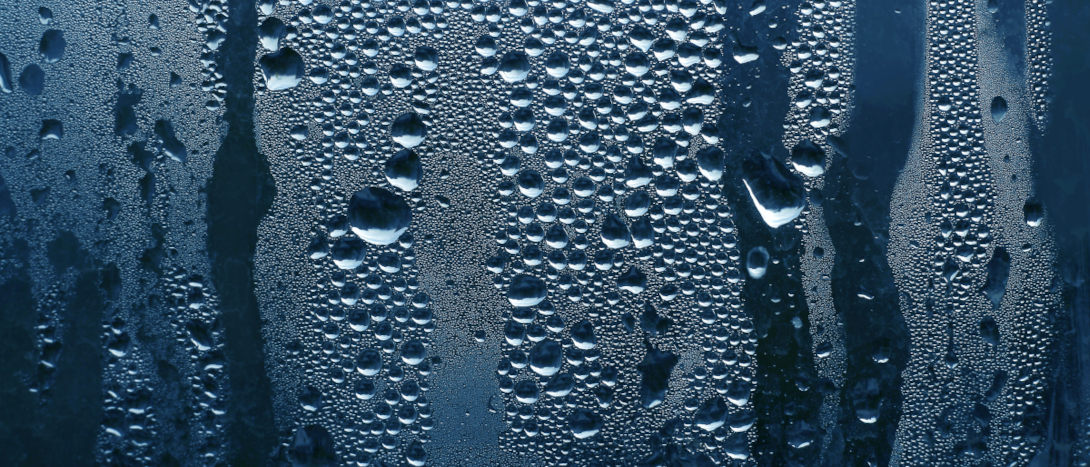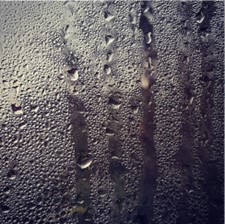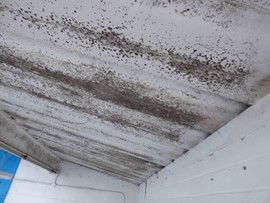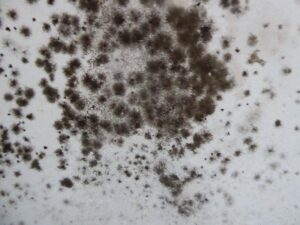

What is Condensation?
Condensation is the process in which water vapour becomes a liquid. It can cause a range of issues from problems to internal finishes, to much more severe issues to the structural integrity of a building.
Two environmental factors combine to determine condensation risk; temperature and humidity. The warmer the air temperature, the greater the quantity of water vapour the air can hold. When the air is at maximum capacity, it is saturated, and its relative humidity (RH) is 100%. The dew point temperature is reached when the RH hits 100%. At this point, if the temperature decreases or the quantity of water vapour increases, then the air’s capacity is breached and excess water is deposited on the coldest surface.
In other words, relative humidity is inversely proportional to the temperature of the air, so a drop in temperature will increase the relative level of humidity to a point where the vapour will condense and liquefy.

Example of condensation formed on a window
What are the Different Types of Condensation?
There are two different types of condensation:
- Surface condensation – when air becomes saturated (100% RH), water droplets condense on cold surfaces such as window glazing, tiles, impermeable gloss paint and vinyl wallpaper.
- Interstitial condensation – where the dew point temperature is reached within the thickness of a building, condensation will form. This commonly occurs when moist air permeates through elements of a building fabric, within which there is a temperature difference. This is typically when warm, moist, internal air moves towards the cooler external areas, driven by a pressure difference. If the temperature change is significant enough, condensation will occur.
What is the Link Between Condensation and Mould?
Mould and mildew are typically caused by condensation. They thrive in warm and moist conditions such as those created by condensation appearing as black spots usually on walls, ceilings and poorly ventilated spaces such as cupboards. Examples from a recent survey we undertook are included below.

Mould growth on an internal profiled fibre cement liner sheet.

Detailed view of mould growth
What are the Problems Caused by Condensation?
- Health risks – mould growth can be a health risk to occupants, particularly the young or elderly, as they produce allergens, irritants and toxic substances.
- Visual deterioration – visual deterioration to internal elements as a result of water becoming trapped causing staining and swelling.
- Structural decay – moisture becoming entrapped within the structure can result in long-term structural damage such as corrosion to metal components, timber rot, swelling timber and damage to cladding. Remedial work can be costly.
- Energy efficiency – where insulation becomes saturated, a building’s thermal performance and efficiency will be reduced leading to an increase in energy costs.
How do you Control Condensation?
- Limit sources of moisture – this can be as simple as keeping lids on pans when cooking, taking shorter showers and drying clothes outside. The general point is to limit activities which produce moisture.
- Increase air and surface temperatures – air temperatures can be increased by utilising a building’s heating system more often and surface temperatures can be increased by installing insulation or by improving glazing.
- Dehumidification – this can be achieved naturally through ventilation or mechanically through the use of a dehumidifier.
- Ventilation – this can be achieved using both natural ventilation techniques such as opening windows, and mechanical ventilation by using extraction vents etc.
- Avoid cold bridges – cold bridging occurs where there is a gap in a building’s insulation often at the roof/wall junction where the wall insulation meets the roof insulation. Condensation is attracted to the colder uninsulated building components. To prevent this, ensure there are no gaps in the insulation.
- Install vapour barriers – these prevent moisture from diffusing through the building fabric to a point where temperatures might be low enough to reach dew point.
DISCLAIMER: This article is for general information only and not intended as advice. Each project has its own set of unique circumstances, all potential issues should be investigated by a surveyor on a case by case basis before making any decision.



